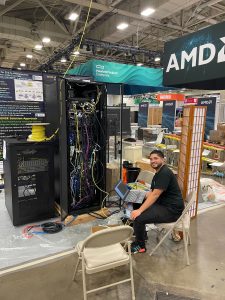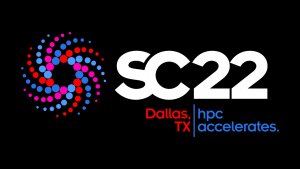 The SC Conference Series is a test bed for cutting-edge developments in high-performance networking, computing, storage, and analysis. Network Research Exhibition (NRE) demonstrations leverage the advanced capabilities of SCinet, SC’s dedicated high-capacity network.
The SC Conference Series is a test bed for cutting-edge developments in high-performance networking, computing, storage, and analysis. Network Research Exhibition (NRE) demonstrations leverage the advanced capabilities of SCinet, SC’s dedicated high-capacity network.
Additionally, each year, a selection of NRE participants are invited to share the results of their demos and experiments from the preceding year’s conference as part of the Innovating the Network for Data-Intensive Science (INDIS) Workshop.
Network researchers and professionals from government, education, research, and industry are invited to submit proposals for demonstrations and experiments at the SC Conference that display innovation in emerging network hardware, protocols, and advanced network-intensive scientific applications.
This year the AmLight infrastructure carried out multiple Network Research Exhibitions to support Research and Educational Networks (RENs) high-performance showcases.
 SC22-NRE-009 PDF
SC22-NRE-009 PDF
High Speed Network with International P4 Experimental Networks for The Global Research Platform and Other Research Platforms
Location: Booth 2847 (StarLight)
An international collaboration has been established to design, develop, implement, and operate a highly distributed environment – the Global Research Platform (GRP) for large scale international science collaborations. For SC22, GRP will provide remote and show floor science resources orchestration and monitoring services for a number of NRE projects, experiments, and demonstrations. These experiments and demonstrations showcase the capabilities of the GRP to support large scale data intensive world-wide science research. Additional capabilities will demonstrate globally accessible DTN-as-a-Service capabilities, network programming, including data plane programming with P4 and K8 as a large scale orchestrator for highly distributed workflows.
SC22-NRE-013 PDF
AutoGOLE/SENSE: End-to-End Network Services and Workflow Integration
Location: Booth 2820 (California Institute of Technology)
The GNA-G AutoGOLE/SENSE WG demonstration will present key technologies, methods and a system of dynamic Layer 2 and Layer 3 virtual circuit services to meet the challenges and address the requirements of the largest data intensive science programs, including the Large Hadron Collider (LHC) the Vera Rubin Observatory and programs challenges and programs in many other disciplines. The services are designed to support multiple petabyte transactions across a global footprint, represented by a persistent testbed spanning the US, Europe, Asia Pacific and Latin American regions.
SC22-NRE-016 PDF
Programmable Networking with P4, GEANT RARE/freeRtr and SONIC/PINS
Location: Booth 2820 (California Institute of Technology)
This NRE will demonstrate a L3 overlay network composed of P4 programmable switches from the GNA-G AutoGOLE / SENSE Persistent Multi-Resource Infrastructure and the GEANT RARE P4 testbed, stitched through L2 circuits aggregating capacity from multiple trans continental, international and regional capacity. Exploring the advancements from SONIC and RARE/FreeRtr, using persistent P4 testbeds from GNA-G AutoGOLE and GEANT RARE, they are able to build state of the art networks and provide a pre-production testbed to integrate, validate and showcase: 1) emerging industry architectures/protocols (i.e. SRv6), 2) novel protocols from the NRE community (i.e. PolKA, Packet marking) and 3) a base platform for the evolution of intelligence and orchestration initiatives (i.e. SENSE).
SC22-NRE-019 PDF
Global Petascale to Exascale Workflows for Data Intensive Science Accelerated by Next Generation Programmable Network Architectures and Machine Learning Applications
Location: Booth 2820 (California Institute of Technology)
This NRE will demonstrate several of the latest major advances in software defined and Terabit/sec networks, intelligent global operations and monitoring systems, workflow optimization methodologies with real-time analytics, and state of the art long distance data transfer methods and tools and server designs, to meet the challenges faced by leading edge data intensive experimental programs in high energy physics, astrophysics, climate and other fields of data intensive science. The key challenges being addressed include: (1) global data distribution, processing, access and analysis, (2) the coordinated use of massive but still limited computing, storage and network resources, and (3) coordinated operation and collaboration within global scientific enterprises each encompassing hundreds to thousands of scientists. The major programs being highlighted include the Large Hadron Collider (LHC), the Laser Interferometer Gravitational Observatory (LIGO), the Large Synoptic Space Telescope (LSST), the Event Horizon Telescope (EHT) that recently released the first black hole image, and others. Several of the SC22 demonstrations will include a fundamentally new concept of “consistent network operations,” where stable load balanced high throughput workflows crossing optimally chosen network paths, up to preset high water marks to accommodate other traffic, provided by autonomous site-resident services dynamically interacting with network-resident services, in response to demands from the science programs’ principal data.
